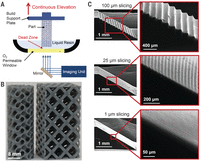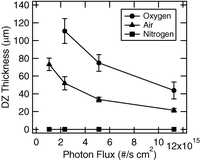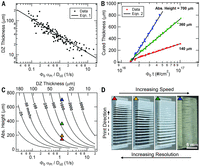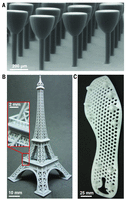Continuous liquid interface production of 3D objects
- John R. Tumbleston1,
- David Shirvanyants1,
- Nikita Ermoshkin1,
- Rima Janusziewicz2,
- Ashley R. Johnson3,
- David Kelly1,
- Kai Chen1,
- Robert Pinschmidt1,
- Jason P. Rolland1,
- Alexander Ermoshkin1,*,
- Edward T. Samulski1,2,*,
- Joseph M. DeSimone1,2,4,*
+Author Affiliations
- ↵*Corresponding author. E-mail: alex@carbon3d.com (A.E.); et@unc.edu (E.T.S.); desimone@email.unc.edu (J.M.D.)
Additive manufacturing processes such as 3D printing use time-consuming, stepwise layer-by-layer approaches to object fabrication. We demonstrate the continuous generation of monolithic polymeric parts up to tens of centimeters in size with feature resolution below 100 micrometers. Continuous liquid interface production is achieved with an oxygen-permeable window below the ultraviolet image projection plane, which creates a “dead zone” (persistent liquid interface) where photopolymerization is inhibited between the window and the polymerizing part. We delineate critical control parameters and show that complex solid parts can be drawn out of the resin at rates of hundreds of millimeters per hour. These print speeds allow parts to be produced in minutes instead of hours.
Additive manufacturing has become a useful technique in a wide variety of applications, including do-it-yourself 3D printing (1, 2), tissue engineering (3–5), materials for energy (6, 7), chemistry reactionware (8), molecular visualization (9, 10), microfluidics (11), and low-density, high-strength materials (12–15). Current additive manufacturing methods such as fused deposition modeling, selective laser sintering, and stereolithography (2, 16) are inordinately slow because they rely on layer-by-layer printing processes. A macroscopic object several centimeters in height can take hours to construct. For additive manufacturing to be viable in mass production, print speeds must increase by at least an order of magnitude while maintaining excellent part accuracy. Although oxygen inhibition of free radical polymerization is a widely encountered obstacle to photopolymerizing UV-curable resins in air, we show how controlled oxygen inhibition can be used to enable simpler and faster stereolithography.
Typically, oxygen inhibition leads to incomplete cure and surface tackiness when photopolymerization is conducted in air (17, 18). Oxygen can either quench the photoexcited photoinitiator or create peroxides by combining with the free radical from the photocleaved photoinitiator (fig. S1). If these oxygen inhibition pathways can be avoided, efficient initiation and propagation of polymer chains will result. When stereolithography is conducted above an oxygen-permeable build window, continuous liquid interface production (CLIP) is enabled by creating an oxygen-containing “dead zone,” a thin uncured liquid layer between the window and the cured part surface. We show that dead zone thicknesses on the order of tens of micrometers are maintained by judicious selection of control parameters (e.g., photon flux and resin optical and curing properties). Simple relationships describe the dead zone thickness and resin curing process, and, in turn, result in a straightforward relationship between print speed and part resolution. We demonstrate that CLIP can be applied to a range of part sizes from undercut micropaddles with stem diameters of 50 μm to complex handheld objects greater than 25 cm in size.
Figure 1A illustrates the simple architecture and operation of a 3D printer that takes advantage of an oxygen-inhibited dead zone. CLIP proceeds via projecting a continuous sequence of UV images (generated by a digital light-processing imaging unit) through an oxygen-permeable, UV-transparent window below a liquid resin bath. The dead zone created above the window maintains a liquid interface below the advancing part. Above the dead zone, the curing part is continuously drawn out of the resin bath, thereby creating suction forces that constantly renew reactive liquid resin. This nonstop process is fundamentally different from traditional bottom-up stereolithography printers, where UV exposure, resin renewal, and part movement must be conducted in separate and discrete steps (fig. S2). Even for inverted top-down approaches in which photopolymerization occurs at an air-resin interface [i.e., the part is successively lowered into a resin bath during printing (16, 19)], these steps must be conducted sequentially for the formation of each layer. Because each step takes several seconds to implement for each layer, and because each layer of a part has a typical thickness of 50 to 100 μm, vertical print speeds are restricted to a few millimeters per hour (16). By contrast, the print speed for CLIP is limited by resin cure rates and viscosity (discussed below), not by stepwise layer formation. For example, the gyroid and argyle structures shown in Fig. 1B were printed at 500 mm/hour, reaching a height of ~5 cm in less than 10 min (movies S1 and S2). An additional benefit of a continual process is that the choice of 3D model slicing thickness, which affects part resolution, does not influence print speed, as shown in the ramp test patterns in Fig. 1C. Because CLIP is continuous, the refresh rate of projected images can be increased without altering print speed, ultimately allowing for smooth 3D objects with no model slicing artifacts.
(A) Schematic of CLIP printer where the part (gyroid) is produced continuously by simultaneously elevating the build support plate while changing the 2D cross-sectional UV images from the imaging unit. The oxygen-permeable window creates a dead zone (persistent liquid interface) between the elevating part and the window. (B) Resulting parts via CLIP, a gyroid (left) and an argyle (right), were elevated at print speeds of 500 mm/hour (movies S1 and S2). (C) Ramp test patterns produced at the same print speed regardless of 3D model slicing thickness (100 μm, 25 μm, and 1 μm).
Establishing an oxygen-inhibited dead zone is fundamental to the CLIP process. CLIP uses an amorphous fluoropolymer window (Teflon AF 2400) with excellent oxygen permeability (1000 barrers; 1 barrer = 10-10cm3(STP) cm cm-2 s-1 cmHg-1) (20), UV transparency, and chemical inertness. Dead zone thickness measurements using a differential thickness technique (fig. S3) demonstrate the importance of both oxygen supply and oxygen permeability of the window in establishing the dead zone. Figure 2 shows that the dead zone thickness when pure oxygen is used below the window is about twice the thickness when air is used, with the dead zone becoming thinner as the incident photon flux increases (see below). When nitrogen is used below the window, the dead zone vanishes. A dead zone also does not form when Teflon AF 2400 is replaced by a material with very poor oxygen permeability, such as glass or polyethylene, even if oxygen is present below the window. Without a suitable dead zone, continuous part production is not possible.
Dead zone thickness is shown as a function of incident photon flux. When pure oxygen is used below the gas-permeable window, the dead zone thickness increases. If nitrogen is used, the dead zone vanishes, resulting in adhesion of the cured resin to the window. Error bars represent SD of 10 measurements of the same conditions.
For the case of ambient air below the window, Fig. 3A shows the dependence of dead zone thickness on incident photon flux (Φ0), photoinitiator absorption coefficient (αPI), and resin curing dosage (Dc0). These three control parameters are related to dead zone thickness according to (1)where Φ0 is the number of incident photons at the image plane per area per time, αPI is the product of photoinitiator concentration and the wavelength-dependent absorptivity, Dc0 quantifies the resin reactivity of a monomer-photoinitiator combination (fig. S4), and C is a proportionality constant. This relationship is similar to the one that describes photopolymerizable particle formation in microfluidic devices that use oxygen-permeable channel walls (21, 22). The dead zone thickness behaves as follows: Increasing either Φ0 or αPI increases the concentration of free radicals in the resin (fig. S1) and decreases the initial oxygen concentration by reaction. Additional oxygen diffuses through the window and into the resin but decays with distance from the window, so that free radicals will overpower inhibiting oxygen at some distance from the window. At the threshold distance where all oxygen is consumed and free radicals still exist, polymerization will begin. Increasing the reactivity of the resin (i.e., decreasing Dc0) causes the polymerization threshold distance from the window to also shrink, thus making the dead zone thinner. The proportionality constant C in Eq. 1 has a value of ~30 for our case of 100-μm-thick Teflon AF 2400 with air below the window, and has units of the square root of diffusivity. The flux of oxygen through the window is also important in maintaining a stable dead zone over time, which is commonly described in terms of the ratio of film permeability to film thickness (23). Using these relationships enables careful control of the dead zone, which provides a critical resin renewal layer between the window and the advancing part.
(1)where Φ0 is the number of incident photons at the image plane per area per time, αPI is the product of photoinitiator concentration and the wavelength-dependent absorptivity, Dc0 quantifies the resin reactivity of a monomer-photoinitiator combination (fig. S4), and C is a proportionality constant. This relationship is similar to the one that describes photopolymerizable particle formation in microfluidic devices that use oxygen-permeable channel walls (21, 22). The dead zone thickness behaves as follows: Increasing either Φ0 or αPI increases the concentration of free radicals in the resin (fig. S1) and decreases the initial oxygen concentration by reaction. Additional oxygen diffuses through the window and into the resin but decays with distance from the window, so that free radicals will overpower inhibiting oxygen at some distance from the window. At the threshold distance where all oxygen is consumed and free radicals still exist, polymerization will begin. Increasing the reactivity of the resin (i.e., decreasing Dc0) causes the polymerization threshold distance from the window to also shrink, thus making the dead zone thinner. The proportionality constant C in Eq. 1 has a value of ~30 for our case of 100-μm-thick Teflon AF 2400 with air below the window, and has units of the square root of diffusivity. The flux of oxygen through the window is also important in maintaining a stable dead zone over time, which is commonly described in terms of the ratio of film permeability to film thickness (23). Using these relationships enables careful control of the dead zone, which provides a critical resin renewal layer between the window and the advancing part.
(A) Liquid interface dead zone (DZ) thickness as a function of Φ0αPI/Dc0. These parameters have typical ranges: 5 × 1014 cm2s–1 < Φ0 < 2 × 1016 cm2 s–1; 2 × 10–4 μm–1 < αPI < 1 × 10–2 μm–1; 5 × 1012 cm2 μm–1 < Dc0 < 5 × 1013 cm2 μm–1. (B) Cured thickness as a function of UV photon dosage (Φ0t) for three resins with different hA controlled with dye loading. (C) CLIP print speed contours as functions of hA and Φ0αPI/Dc0. (D) Photographs of resolution test patterns using resins with differenthA from (B). Colored triangles correspond to process conditions in (C). The dye-free test pattern produced at highest print speed (blue triangle) is semitransparent.
Above the dead zone, photopolymerization occurs to a certain cured thickness that depends on Φ0αPI/Dc0 along with exposure time (t) and the resin absorption coefficient (α) according to the relationship (2)Figure 3B shows cured thickness for three different resins with varying α (holding αPI constant) where thicknesses were measured for different UV photon dosages (products of Φ0 and t) (fig. S3). These curves are akin to the so-called “working curves” used in stereolithography resin characterization (16, 19). For these resins, α is varied by adjusting the concentration of an absorbing dye or pigment that passively absorbs light (i.e., does not produce radicals) but contributes to overall resin absorption via α = αPI + αdye. Note that α is the inverse of the characteristic optical absorption height (hA) of the resin:
(2)Figure 3B shows cured thickness for three different resins with varying α (holding αPI constant) where thicknesses were measured for different UV photon dosages (products of Φ0 and t) (fig. S3). These curves are akin to the so-called “working curves” used in stereolithography resin characterization (16, 19). For these resins, α is varied by adjusting the concentration of an absorbing dye or pigment that passively absorbs light (i.e., does not produce radicals) but contributes to overall resin absorption via α = αPI + αdye. Note that α is the inverse of the characteristic optical absorption height (hA) of the resin: (3)The value of hA, in conjunction with the model slicing thickness (Fig. 1C), projected pixel size, and image quality, determines the part resolution. The projected pixel size (typically between 10 and 100 μm) and image quality are functions of the imaging setup and determine lateral part resolution. As with slicing thickness, hA affects vertical resolution but is a property of the resin. If hA is high, then previously cured 2D patterns will continue to be exposed, causing unintentional overcuring and “print-through,” which in turn results in defects for undercut and overhang geometries.
(3)The value of hA, in conjunction with the model slicing thickness (Fig. 1C), projected pixel size, and image quality, determines the part resolution. The projected pixel size (typically between 10 and 100 μm) and image quality are functions of the imaging setup and determine lateral part resolution. As with slicing thickness, hA affects vertical resolution but is a property of the resin. If hA is high, then previously cured 2D patterns will continue to be exposed, causing unintentional overcuring and “print-through,” which in turn results in defects for undercut and overhang geometries.
From the expressions for dead zone thickness and cured thickness, a simple relationship among print speed, hA(i.e., resolution), and Φ0αPI/Dc0 is derived: (4)(see supplementary materials). Figure 3C shows a contour plot of speed as a function of hA and the ratio Φ0αPI/Dc0; the dead zone thickness (Eq. 1) is indicated. For a given hA, speed can be increased by increasing Φ0or αPI or by using a resin with lower Dc0. However, as speed increases, dead zone thickness decreases and will eventually become too thin for the process to remain stable. For CLIP, the empirically determined minimum dead zone thickness is ~20 to 30 μm. Part production with a dead zone thickness below this minimum is possible but can lead to window adhesion–related defects. Once the minimum dead zone thickness is reached, the print speed can only be increased by relaxing the resolution (i.e., using a resin with higher hA).
(4)(see supplementary materials). Figure 3C shows a contour plot of speed as a function of hA and the ratio Φ0αPI/Dc0; the dead zone thickness (Eq. 1) is indicated. For a given hA, speed can be increased by increasing Φ0or αPI or by using a resin with lower Dc0. However, as speed increases, dead zone thickness decreases and will eventually become too thin for the process to remain stable. For CLIP, the empirically determined minimum dead zone thickness is ~20 to 30 μm. Part production with a dead zone thickness below this minimum is possible but can lead to window adhesion–related defects. Once the minimum dead zone thickness is reached, the print speed can only be increased by relaxing the resolution (i.e., using a resin with higher hA).
This analysis shows that for a dead zone thickness of 20 μm, speeds in excess of 300 mm/hour with hA = 100 μm are accessible. By increasing hA to 300 μm and sacrificing resolution, speeds greater than 1000 mm/hour are readily achieved. The trade off between speed and resolution is demonstrated in Fig. 3D with resolution test patterns using the resins with different hA from Fig. 3B (all have equivalent Φ0αPI/Dc0 and dead zone thickness). As dye loading is increased, hA is reduced, leading to less print-through and ultimately higher resolution. However, dye absorption does not produce free radicals, so resins with lower hA require greater dosages to adequately solidify; that is, parts must be elevated more slowly for constant photon flux. On the other hand, the resin without dye and with the highest hA can be printed at the greatest speed but with poor resolution (as shown by unintentional curing of the overhangs in the test pattern).
Using this process control framework, Fig. 4 shows an array of expediently produced parts ranging in size from undercut micropaddles with stem diameters of 50 μm (Fig. 4A) to full-size shoe cleats 25 cm in length (Fig. 4C). The Eiffel Tower model in Fig. 4B illustrates that fine detail is achieved even in macroscale parts: The horizontal railing posts (diameter <500 μm) are resolved on this 10-cm-tall model. This ratio of scales (1:200) confirms that the CLIP process enables rapid production of arbitrary microscopic features over parts having macroscopic dimensions. For these parts, the speed-limiting process is resin curing (Eq. 4); however, for other part geometries, the speed-limiting process is resin flow into the build area. For such geometries with comparatively wide solid cross sections, parameters that affect resin flow (e.g., resin viscosity, suction pressure gradient) become important to optimize.
(A) Micropaddles with stems 50 μm in diameter. (B) Eiffel Tower model, 10 cm tall. (C) A shoe cleat >20 cm in length. Even in large parts, fine detail is achieved, as shown in the inset of (B) where features <1 mm in size are obtained. The micropaddles were printed at 25 mm/hour; the Eiffel Tower model and shoe cleat were printed at 100 mm/hour.
Preliminary studies show that the CLIP process is compatible with producing parts from soft elastic materials (24,25), ceramics (26), and biological materials (27, 28). CLIP has the potential to extend the utility of additive manufacturing to many areas of science and technology, and to lower the manufacturing costs of complex polymer-based objects.
Supplementary Materials
www.sciencemag.org/content/347/6228/1349/suppl/DC1
Materials and Methods
Supplementary Text
Figs. S1 to S4
Movies S1 and S2
Reference (29)
- Received for publication 5 November 2014.
- Accepted for publication 3 February 2015.
References and Notes
- ↵
- J. M. Pearce
- ↵
H. Lipson, M. Kurman, Fabricated: The New World of 3D Printing (Wiley, Indianapolis, 2013).
- ↵
- B. Derby
-
- A. Atala,
- F. K. Kasper,
- A. G. Mikos
- ↵
- B. C. Gross,
- J. L. Erkal,
- S. Y. Lockwood,
- C. Chen,
- D. M. Spence
- ↵
- K. Sun,
- T. S. Wei,
- B. Y. Ahn,
- J. Y. Seo,
- S. J. Dillon,
- J. A. Lewis
- ↵
- G. Chisholm,
- P. J. Kitson,
- N. D. Kirkaldy,
- L. G. Bloor,
- L. Cronin
- ↵
- M. D. Symes,
- P. J. Kitson,
- J. Yan,
- C. J. Richmond,
- G. J. Cooper,
- R. W. Bowman,
- T. Vilbrandt,
- L. Cronin
- ↵
- P. Chakraborty,
- R. N. Zuckermann
- ↵
- P. J. Kitson,
- A. Macdonell,
- S. Tsuda,
- H. Y. Zang,
- D.-L. Long,
- L. Cronin
- ↵
- J. L. Erkal,
- A. Selimovic,
- B. C. Gross,
- S. Y. Lockwood,
- E. L. Walton,
- S. McNamara,
- R. S. Martin,
- D. M. Spence
- ↵
- X. Zheng,
- H. Lee,
- T. H. Weisgraber,
- M. Shusteff,
- J. DeOtte,
- E. B. Duoss,
- J. D. Kuntz,
- M. M. Biener,
- Q. Ge,
- J. A. Jackson,
- S. O. Kucheyev,
- N. X. Fang,
- C. M. Spadaccini
-
- T. A. Schaedler,
- A. J. Jacobsen,
- A. Torrents,
- A. E. Sorensen,
- J. Lian,
- J. R. Greer,
- L. Valdevit,
- W. B. Carter
-
- J. Bauer,
- S. Hengsbach,
- I. Tesari,
- R. Schwaiger,
- O. Kraft
- ↵
- E. B. Duoss
- et al
- ↵
I. Gibson, D. W. Rosen, B. Stucker, Additive Manufacturing Technologies: Rapid Prototyping to Direct Digital Manufacturing (Springer, New York, 2010).
- ↵
- S. C. Ligon,
- B. Husár,
- H. Wutzel,
- R. Holman,
- R. Liska
- ↵
- Y. Yagci,
- S. Jockusch,
- N. J. Turro
- ↵
P. F. Jacobs, Rapid Prototyping & Manufacturing: Fundamentals of StereoLithography (Society of Manufacturing Engineers, Dearborn, MI, 1992).
- ↵
T. C. Merkel, I. Pinnau, R. Prabhakar, B. D. Freeman, Materials Science of Membranes for Gas and Vapor Separation (Wiley, West Sussex, UK, 2006), pp. 251–270.
- ↵
- D. Dendukuri,
- P. Panda,
- R. Haghgooie,
- J. M. Kim,
- T. A. Hatton,
- P. S. Doyle
- ↵
- D. Dendukuri,
- D. C. Pregibon,
- J. Collins,
- T. A. Hatton,
- P. S. Doyle
- ↵
- J. M. Gonzalez-Meijome,
- V. Compañ-Moreno,
- E. Riande
- ↵
- J. A. Rogers,
- T. Someya,
- Y. Huang
- ↵
- S. Bauer,
- S. Bauer-Gogonea,
- I. Graz,
- M. Kaltenbrunner,
- C. Keplinger,
- R. Schwödiauer
- ↵
- N. Travitzky,
- A. Bonet,
- B. Dermeik,
- T. Fey,
- I. Filbert-Demut,
- L. Schlier,
- T. Schlordt,
- P. Greil
- ↵
- C. Cvetkovic,
- R. Raman,
- V. Chan,
- B. J. Williams,
- M. Tolish,
- P. Bajaj,
- M. S. Sakar,
- H. H. Asada,
- M. T. Saif,
- R. Bashir
- ↵
- Y. Lu,
- G. Mapili,
- G. Suhali,
- S. Chen,
- K. Roy
- ↵
- S. K. Suh,
- K. W. Bong,
- T. A. Hatton,
- P. S. Doyle
-
Acknowledgments: This work was sponsored by Carbon3D Inc. J.R.T., D.S., N.E., D.K., R.P., J.P.R., A.E., E.T.S., and J.M.D. all have an equity stake in Carbon3D Inc., which is a venture-backed startup company. Continuous liquid interface printing is the subject of patent protection including Patent Cooperation Treaty publication numbers WO 2014/126837 A2, WO 2014/126830 A2, and WO 2014/126834 A2, and others.




